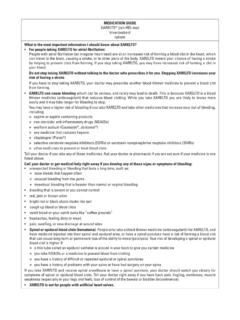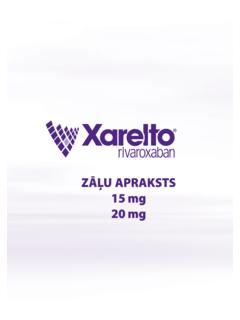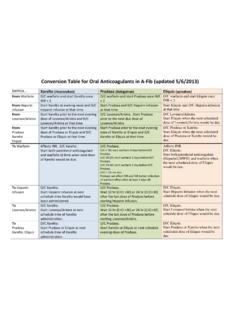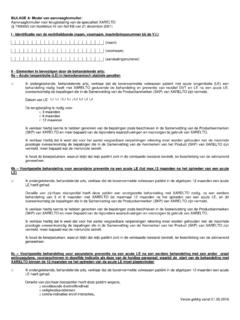Transcription of DATA SHEET 1. PRODUCT NAME (strength …
1 171211 xarelto DS Page 1 of 35 DATA SHEET 1. PRODUCT NAME (strength pharmaceutical form) xarelto 10 mg film-coated tablets xarelto 15 mg film-coated tablets xarelto 20 mg film-coated tablets 2. QUALITATIVE AND QUANTITATIVE COMPOSITION Rivaroxaban is an odourless, non-hygroscopic white to yellowish powder. Rivaroxaban is practically insoluble in water and aqueous media in the pH range 1 to 9. An amount of approximately 5 - 7 mg/L rivaroxaban is pH-independently soluble in aqueous media at 25 C. Rivaroxaban is only slightly soluble in organic solvents ( acetone, polyethylene glycol 400). xarelto 10 mg 1 film-coated tablet contains 10 mg rivaroxaban. Each 10 mg film-coated tablet contains mg lactose monohydrate (= mg lactose) per tablet. For a full list of excipient(s) see section xarelto 15 mg 1 film-coated tablet contains 15 mg rivaroxaban. Each 15 mg film-coated tablet contains mg lactose monohydrate (= mg lactose) per tablet.
2 For a full list of excipient(s) see section xarelto 20 mg 1 film-coated tablet contains 20 mg rivaroxaban. Each 20 mg film-coated tablet contains mg lactose monohydrate (= mg lactose) per tablet. For a full list of excipient(s) see section 3. PHARMACEUTICAL FORM xarelto 10 mg Film-coated, round, biconvex, light red immediate release tablets of 6 mm diameter and 9 mm radius of curvature and weight of mg for oral use. Bayer-cross on the bottom side and 10 and a triangle on the top side. xarelto 15 mg Film-coated, round, biconvex, red tablets of 6 mm diameter, 9 mm radius of curvature and weight of mg for oral use. Bayer-cross on one side and triangle and 15 on the other side. xarelto 20 mg Film-coated, round, biconvex, brown red tablets of 6 mm diameter, 9 mm radius of curvature and weight of mg for oral use. Bayer-cross on one side and triangle and 20 on the other side.
3 171211 xarelto DS Page 2 of 35 4. CLINICAL PARTICULARS Therapeutic indications xarelto is indicated for Prevention of venous thromboembolism (VTE) in adult patients undergoing elective hip or knee replacement surgery. Prevention of stroke and systemic embolism in adult patients with non-valvular atrial fibrillation with one or more risk factors, such as congestive heart failure, hypertension, age 75 years, diabetes mellitus, prior stroke or transient ischaemic attack. Treatment of deep vein thrombosis (DVT) and pulmonary embolism (PE) and for the prevention of recurrent DVT and pulmonary embolism (see section for haemodynamically unstable PE patients). Dose and method of administration Dose VTE Prevention in total hip and knee replacement The recommended dose of xarelto for VTE prevention in major orthopaedic surgery of the lower limbs (elective total hip or knee replacement) is a 10 mg tablet taken once daily.
4 The initial dose should be taken 6 - 10 hours after surgery provided that haemostasis has been established. The duration of treatment depends on the type of major orthopaedic surgery. For patients undergoing hip replacement surgery, a treatment duration of 5 weeks is recommended. For patients undergoing knee replacement surgery, a treatment duration of 2 weeks is recommended. Dose of 10 mg once daily and duration specified for each type of surgery is not to be exceeded. Stroke Prevention in Atrial Fibrillation The recommended dose is 20 mg once daily. For patients with moderate renal impairment (Creatinine clearance: 30 49 mL/min), one 15 mg tablet of xarelto should be taken once daily. Therapy with xarelto should be continued long term provided the benefit of prevention of stroke and systemic embolism outweighs the risk of bleeding.
5 Cardioversion xarelto can be initiated or continued in patients who may require cardioversion. For TOE-guided cardioversion in patients not previously treated with anticoagulants, xarelto treatment should be started at least 4 hours before cardioversion to ensure adequate anticoagulation (see sections and ). Treatment of DVT and PE and prevention of recurrent DVT and PE The recommended dose for the initial treatment of acute DVT and PE is 15 mg xarelto twice daily for the first three weeks followed by 20 mg xarelto once daily for the continued treatment and the prevention of recurrent DVT and PE. During the initial 3 weeks of acute treatment 15 mg of xarelto should be taken twice daily. 171211 xarelto DS Page 3 of 35 After the initial 3 weeks treatment xarelto should be continued at 20 mg once daily. Therapy should be continued as long as the VTE risk persists.
6 The duration of therapy should be individualised after careful assessment of the treatment benefit against the risk for bleeding. xarelto 15 mg tablets and xarelto 20 mg tablets should be taken with food. Special Populations Hepatic impairment xarelto is contraindicated in patients with significant hepatic disease (including moderate to severe hepatic impairment, Child-Pugh B and C) which is associated with coagulopathy leading to a clinically relevant bleeding risk (see section ). No dose adjustment is necessary in patients with other hepatic diseases (see section ). Limited clinical data in patients with moderate hepatic impairment (Child-Pugh B) indicate a significant increase in the pharmacological activity. No clinical data are available for patients with severe hepatic impairment (Child-Pugh C) (see sections and ). Renal impairment Prior to commencing treatment with xarelto , an accurate assessment of renal function should be undertaken, especially if there is any suspicion that the person may have a degree of renal impairment (see section ) No clinical data are available for patients with CrCl < 15 mL/min or patients on dialysis.
7 Therefore, use of xarelto is contraindicated in this patient population (see section ). Please refer to Table 1 below for dosing instructions for patients with renal impairment by indications. Table 1: Dosage and administration advice for patients with reduced renal function Indication Creatinine Clearance (CrCl) VTE Prevention in total hip and knee replacement Stroke Prevention in Atrial Fibrillation Treatment of DVT and PE and prevention of recurrent DVT and PE Normal > 80 mL/min 10 mg once daily 20 mg once daily 15 mg twice daily for 3 weeks, followed by 20 mg once daily Mild 50 80 mL/min Moderate 30 49 mL/min 10 mg once daily 15 mg once daily 15 mg twice daily for 3 weeks, followed by 20 mg once daily Severe 15 29 mL/min 10 mg once daily (Use with caution)
8 xarelto is contraindicated Severe < 15 mL/min xarelto is contraindicated Patients above 65 years Based on clinical data, no dose adjustment is required for these patient populations (see section ). Increasing age is associated with declining renal function. Body weight No dose adjustment is required for these patient populations (see section ). 171211 xarelto DS Page 4 of 35 Gender No dose adjustment is required for these patient populations (see section ). Children and adolescents xarelto is not recommended for use in children or adolescents below 18 years of age due to a lack of data on safety and efficacy. Ethnic differences No dose adjustment is required based on ethnic differences (see section ). Switch from Vitamin K Antagonists (VKA) to xarelto : For patients treated for prevention of stroke and systemic embolism, VKA treatment should be stopped and xarelto therapy should be initiated once the INR is For patients treated for DVT and prevention of recurrent DVT and PE, VKA treatment should be stopped and xarelto therapy should be initiated once the INR is The INR is not a valid measure for the anticoagulant activity of xarelto , and therefore should not be used.
9 The INR is only calibrated and validated for VKAs and cannot be used for any other anticoagulant. When switching patients from VKAs to xarelto , INR values will be elevated after the intake of xarelto but this is not indicative of the anticoagulant effect of xarelto (see section ). Switch from Parenteral Anticoagulants to xarelto : For patients currently receiving a parenteral anticoagulant, start xarelto 0 to 2 hours before the time of the next scheduled administration of the parenteral drug ( , LMWH) or at the time of discontinuation of a continuously administered parenteral drug ( , intravenous unfractionated heparin). Switch from xarelto to Parenteral Anticoagulants: Discontinue xarelto and give the first dose of parenteral anticoagulant at the time that the next xarelto dose would be taken. Switch from xarelto to VKAs There is a potential for inadequate anticoagulation during the transition from xarelto to VKA.
10 Limited clinical trial data are available to guide the process whereby patients are converted from xarelto to VKAs. Continuous adequate anticoagulation should be ensured during transition to an alternate anticoagulant. In patients converting from xarelto to VKA, VKA should be given concurrently until the INR is It should be noted that xarelto can contribute to an elevated INR and so INR measurements made during co-administration with warfarin may not be useful for determining the appropriate dose of VKA. Therefore, INR measurements should be made in accordance with the following guidance during the transition from xarelto to VKA. For the first two days of the conversion period, standard initial dosing of VKA should be used and, after the first two days VKA dosing should be guided by INR testing. While patients are on both xarelto and VKA, INR should be tested just prior to the next dose of xarelto (not earlier than 24 hours after the previous dose).
















